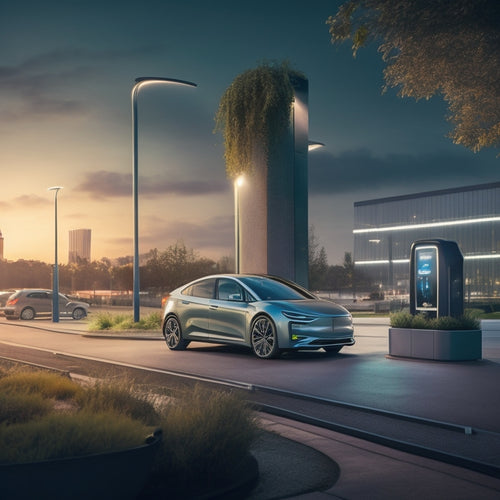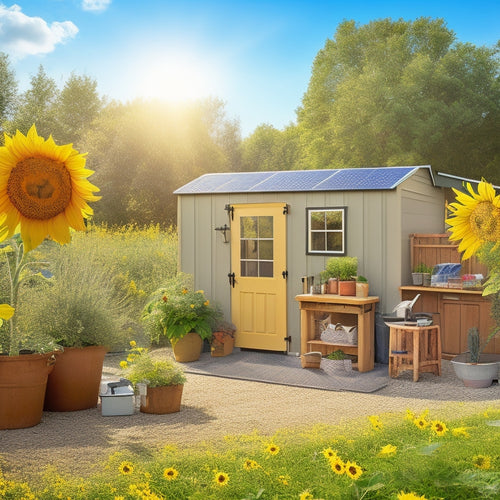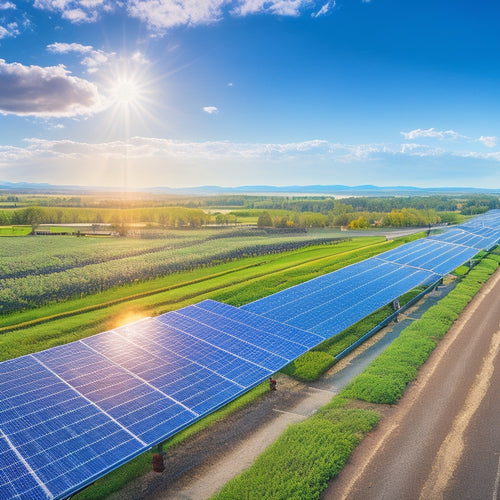
5 Essential Inverters for Renewable Energy Systems
Share
You're looking to optimize your renewable energy system with the right inverters, which can greatly impact your energy independence and cost savings. Top-rated string inverters from brands like SMA and Fronius can efficiently convert DC power from solar panels or wind turbines to AC electricity. Microinverters, like Enphase, offer maximum efficiency by optimizing energy production from each panel individually. Hybrid inverters integrate multiple power sources, including solar, batteries, and generators, while grid-tie inverters synchronize with the grid to reduce energy bills. Off-grid inverters are ideal for remote locations, and each type has its unique features and requirements. Now, you're one step closer to finding the perfect inverter for your system.
Overview
- String inverters convert DC power from solar panels/wind turbines to AC electricity, offering high-efficiency models from brands like SMA and Fronius.
- Microinverters optimize energy production from each solar panel individually, allowing for real-time monitoring and improved safety features.
- Hybrid inverters manage multiple power sources, including solar, batteries, and generators, storing excess energy for later use and increasing energy independence.
- Grid-tie inverters synchronize with the grid, allowing excess energy feed-in and reducing energy bills, while featuring Maximum Power Point Tracking for optimal energy harvest.
- Off-grid inverters convert DC power from renewable sources for remote energy needs, requiring battery compatibility and high-efficiency designs above 95% for efficient energy harvesting.
Top-Rated String Inverters for Homes
When it comes to harvesting renewable energy for your home, a string inverter plays an essential role in converting DC power from your solar panels or wind turbines into usable AC electricity.
You'll want to choose a reliable brand that can efficiently handle the power output of your system. Consider evaluating your energy requirements and sizing your inverter accordingly, taking into consideration daily energy usage and roof space to guarantee peak energy harvesting.
Look for top-rated brands like SMA, Fronius, and Enphase, which offer high-efficiency models with advanced monitoring capabilities.
During installation, make certain to follow proper grounding and wiring procedures to ascertain safe and efficient operation. Additionally, consider installing your inverter in a shaded area to prevent overheating, and keep it easily accessible for routine maintenance.
Microinverters for Maximum Efficiency
Opting for microinverters can greatly enhance the overall efficiency of your renewable energy system. These compact devices convert DC power from individual solar panels to AC power, allowing for maximum energy harvesting. With microinverter technology, you can monitor and control each panel's performance, identifying any issues quickly.
Here are some key benefits and installation tips to take into account:
| Benefit | Description | Installation Tip |
|---|---|---|
| Increased Energy Yield | Microinverters optimize energy production from each panel | Verify proper panel alignment and cleaning |
| Real-time Monitoring | Monitor individual panel performance remotely | Use a reliable communication network for data transmission |
| Improved Safety | Microinverters reduce the risk of electrical shock | Follow manufacturer guidelines for installation and maintenance |
| Flexibility | Microinverters can be used with different panel sizes and types | Plan your installation to accommodate future system expansion |
Hybrid Inverters for Solar Power
Hybrid inverters, a type of multi-mode inverter, have gained popularity in solar power systems due to their unique ability to manage multiple power sources simultaneously.
You can now utilize the power of the sun while also utilizing energy from other sources, such as batteries or generators. This hybrid functionality allows you to optimize your energy management, ensuring a stable and efficient power supply.
With a hybrid inverter, you can store excess energy generated during the day for later use, reducing your reliance on the grid and increasing your energy independence.
By integrating multiple power sources, you'll experience a more reliable and efficient energy system, giving you the freedom to power your life on your own terms.
High-efficiency inverter options with high conversion efficiency ratings and advanced features like monitoring and control systems for real-time tracking further enhance the benefits of hybrid inverters.
Grid-Tie Inverters for Energy Savings
Grid-tie inverters are designed to synchronize with the grid's frequency and voltage, allowing you to feed excess energy back into the grid and offset your energy consumption. This means you can reduce your energy bills and even earn credits from your utility company. With grid-tie inverters, you can monitor your energy production and consumption in real-time, making it easier to optimize your energy management.
| Inverter Feature | Description | Benefit |
|---|---|---|
| Maximum Power Point Tracking (MPPT) | Optimizes energy harvest from solar panels | Increased energy production |
| Real-time Monitoring | Tracks energy production and consumption | Improved energy management |
| Grid Synchronization | Guarantees safe and efficient energy feed-in | Reliable and efficient energy offset |
| DC-AC Conversion | Converts DC power from solar panels to AC power for grid feed-in | Efficient energy conversion |
| Safety Features | Includes ground fault detection and arc fault protection | Guarantees safe operation and protection from electrical shocks |
Off-Grid Inverters for Remote Systems
Operating independently of the grid, off-grid inverters are designed to convert DC power from renewable energy sources, such as solar panels or wind turbines, into AC power for remote systems.
You'll find that these inverters are perfect for locations where traditional grid power isn't available or reliable.
When selecting an off-grid inverter, you'll need to take into account battery compatibility, ensuring the inverter can efficiently charge and discharge your batteries.
High-efficiency inverters above 95% with advanced features like MPPT and monitoring capabilities can greatly enhance energy harvesting.
Installation challenges may arise, such as configuring the system to meet your specific energy needs.
Be prepared to invest time in designing and setting up your off-grid system.
However, the payoff is well worth it – you'll enjoy the freedom and independence that comes with generating your own renewable energy.
Frequently Asked Questions
Can I Use a Single Inverter for Multiple Renewable Energy Sources?
You can use a single inverter for multiple renewable energy sources if you guarantee inverter integration and energy source compatibility, allowing you to utilize diverse power sources while minimizing system complexity and costs.
How Do I Maintain and Troubleshoot My Inverter System?
You investigate the theory that regular maintenance can extend your inverter's lifespan; indeed, it's true. You'll commonly face issues like overheating, faulty sensors, and grid connection problems, but troubleshooting guides and scheduled checks will keep your system running smoothly and efficiently.
Are Inverters Compatible With Existing Electrical Infrastructure?
You'll find that some inverter types seamlessly integrate with existing electrical infrastructure, guaranteeing electrical compatibility, while others require modifications or upgrades to secure a smooth changeover, so it's essential to assess your setup before installation.
What Safety Features Should I Look for in an Inverter?
When selecting an inverter, you'll want to look for safety features like overcurrent protection, ground fault detection, and thermal monitoring, ensuring your system operates within safe output power limits while maintaining high inverter efficiency, giving you peace of mind and energy freedom.
Can I Upgrade My Inverter to Accommodate Increasing Energy Demands?
You're not stuck between a rock and a hard place; you can upgrade your inverter to meet increasing energy demands by evaluating your current inverter capacity and exploring options that enhance energy efficiency without breaking the bank.
Ready to Buy
You've now investigated the top inverters for your renewable energy system. As you finalize your selection, remember that the global inverter market is projected to reach $15.6 billion by 2025, with solar inverters taking the largest share. This growth highlights the increasing adoption of renewable energy sources, making inverters an essential component in the shift to a sustainable future.
Related Posts
-

Solid State Batteries in Electric Vehicles
Solid-state batteries revolutionize electric vehicles by offering a longer lifespan and higher energy density than tr...
-

Building an Emergency Backup Solar Power System in 5 Essential Steps
Building an emergency backup solar power system involves five key steps. First, assess your daily energy needs to ide...
-

Applications of Photovoltaic Systems
Photovoltaic systems are versatile, converting sunlight into electricity for various applications. You can use them i...


